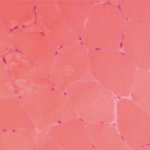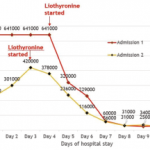Clinical Presentation and Drug Characteristics
Patients may present with mild fatigue to fulminant rhabdomyolysis requiring hospitalization. The most common symptoms are myalgia, weakness, low back and proximal muscle pain or generalized body aches, and/or dyspnea.4 Fatigue and muscle pain are often the most common chief complaint for statin-induced rhabdomyolysis, as are a subacute progression of low back pain and proximal muscle pain over the ensuing weeks.1,4 A high index of suspicion is necessary for any patient presenting with an elevated CK. The time of statin use before the development of rhabdomyolysis can range from one week to four years, the average being about six months to one year.1,4 This timeframe is shortened when a statin is combined with a fibrate, with an average onset of 32 days.4
Statin pharmacodynamics and pharmacokinetics may play a role in the incidence of myopathy.1,7,8 Lovastatin, simvastatin, and atorvastatin are predominantly metabolized by the hepatic microsomal cytochrome (CYP) 450 3A4 system (simvastatin also has some CYP 3A5 metabolism). Both rosuvastatin and fluvastatin are also metabolized via the CYP450 2C9 system, with fluvastatin having some involvement of CYP 3A4 activity. Pravastatin undergoes sulfation and is hydrophilic lending to a lower risk of myopathy.1,7,8 Concurrent administration of a statin with other drugs metabolized by the same CYP450 isozyme leads to higher statin levels and a greater risk of myopathy.1,9 Many drugs which are substrates for the CYP3A4 isozyme and therefore many potential interactions can occur. Drugs with interactions include the following: fibrates (gemfibrozil > fenofibrate), nicotinic acid, cyclosporine, tacrolimus, azoles, macrolides (erythromycin, clarithromycin), protease inhibitors, verapamil, amiodarone, warfarin, fluoxetine, and diazepam.1,7,9 These agents should be used cautiously along with statins.
Because pravastatin and rosuvastatin are more hydrophilic than other statins, they are thought to have lower myopathy risks, but still cause myopathy.1,4,7,10 Since rosuvastatin is a relatively new agent, there are limited data on it.7 The choice of a statin may be more important in patients with moderate to severe renal dysfunction, since this is also a risk factor for myopathy. Both atorvastatin and fluvastatin have minimal renal excretion.1 Other risk factors for statin myopathy include excessive alcohol consumption, cocaine use, strenuous exercise, grapefruit juice ingestion (>1 quart/day), age over 80 years, hypertension, diabeties, a low body mass index, hypothyroidism, hypertriglyceridemia, hepatic disease, genetic polymorphisms of CYP450 isozymes, multisystem disease, among others.1,4,9 Certain genetic determinants may be associated with statin-associated myopathy risk.9,11
Pipeline Update
In February 2008, a Biological Product License Application (BLA) was submitted to the U.S. Food and Drug Administration (FDA) for the pegylated anti–tumor necrosis factor (TNF)-α monoclonal antibody (MAb), certolizumab pegol (Cimzia), for treating rheumatoid arthritis (RA).12 In April 2008, the agent received FDA approval for treating adults with moderate to severe Crohn’s disease.13 UCB has commenced efforts to develop additional rheumatology indications for certolizumab pegol.14 A pooled safety analysis from the certolizumab studies noted a low incidence of injection site pain and therapy discontinuations due to adverse drug reactions. Common side effects were headache, nasopharyngitis, and upper respiratory infections. A drug application for RA was accepted for review in both Canada and Europe in early 2008.15


